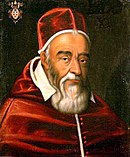March–April 1605 papal conclave
| Papal conclave March 1605 | |
|---|---|
| Dates and location | |
| 14 March – 1 April 1605 Apostolic Palace, Papal States | |
| Elected pope | |
| Alessandro Ottaviano de' Medici Name taken: Leo XI | |
 | |
The papal conclave of March 1605 was convened on the death of Pope Clement VIII and ended in the election of Alessandro Ottaviano de' Medici as Pope Leo XI. It was the first of two papal conclaves in 1605, with Leo dying on 27 April 1605, twenty-six days after he was elected. The conclave was dominated by conflict as to whether Cesare Baronius should be elected pope, and it saw Philip III of Spain exclude both Baronius and the eventually successful candidate, Medici.
Background
In 1596 Clement VIII had accepted Henry IV of France's decision to convert to the Catholic Church, removed the excommunication under which Sixtus V had placed him, and annulled his marriage to Marguerite of Valois. Clement also assisted in arranging Henry's marriage to Marie de' Medici, which established a Catholic succession.[1] Clement worked to decrease the influence of Spanish cardinals in the College of Cardinals. He created five French cardinals, and the Italians cardinals he created were considered neutral. Clement wanted the French cardinals that he created to be present in Rome and to take part in the governance of the Church. Henry IV also demanded that three French cardinals go to Rome, and they were there at Clement's death on 3 March 1605.[2]
Conclave
Cesare Baronius was the favourite candidate, whose odds of being elected were 10:100 according to Roman bookmakers, who took bets on the election despite the prohibition of the practice by Gregory XIV. Baronius received 23 votes during the first scrutiny, which was considered good because many electors who supported him had cast their first ballots for friends.[2] Baronius was the candidate favoured by France, and had the backing of the French cardinals.[3] He was also the first choice candidate of Pietro Aldobrandini, the nephew of Clement VIII.[2]
After the results of the first scrutiny, Cardinal Avila, Philip III of Spain's representative at the conclave, announced that Philip had vetoed Baronius. This led to a clash with Aldobrandi, with both cardinals yelling at the other that they would be willing to make the conclave last over a year in order to elect their respective candidates. Avila and Aldobrandi fought a second time, which led to shouting and pushing; the crowds outside took this as a sign of election by acclamation, and caused them to open the doors of the conclave while it was still continuing.[4]
Baronius came within 9 votes of election, with 32 of the electors supporting him, but he refused to advocate his own election or accept election by acclamation. Aldabrandi was unable to convince some members of his faction to vote for Baronius because they viewed him as too strict, and by 30 March he had resigned himself to look for other candidates.[5]
The election was further complicated by the factional struggles between the Aldabrandi and Montalto factions, whose approximately equal numbers cancelled each other out.[6] Aldabrandi supported Laudivio Zacchia, but eventually transferred his support to Alessandro Ottaviano de' Medici. Medici was related to the French queen, and Henry IV of France had spent significant money on his candidacy.[3]
The Montalto faction transferred their support to Medici on 1 April, securing his election. After the vote, Avila revealed that Philip III had excluded Medici as well, and protested so loudly that he could be heard on the street. Despite this, the cardinals elected Medici and he chose the name Leo XI, in honour of his great-uncle Leo X. His election made Leo the fourth cardinal to be elected pope that had been created by Sixtus V in his consistory in 1583.[5]
References
- ^ Baumgartner, Frederic J. (2003). Behind Locked Doors. Palgrave Macmillan. p. 138. ISBN 0-312-29463-8.
- ^ a b c Baumgartner, Frederic J. (2003). Behind Locked Doors. Palgrave Macmillan. p. 139. ISBN 0-312-29463-8.
- ^ a b Walsh, Michael J. (2003). The Conclave: A Sometimes Secret and Occasionally Bloody History of Papal Elections. Rowman & Littlefield. p. 125. ISBN 9781580511353.
- ^ Baumgartner, Frederic J. (2003). Behind Locked Doors. Palgrave Macmillan. pp. 139–140. ISBN 0-312-29463-8.
- ^ a b Baumgartner, Frederic J. (2003). Behind Locked Doors. Palgrave Macmillan. p. 140. ISBN 0-312-29463-8.
- ^ Hsia, R. Po-Chia (2005). The World of Catholic Renewal, 1540–1770. Cambridge University Press. p. 99. ISBN 9780521841542.
